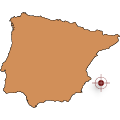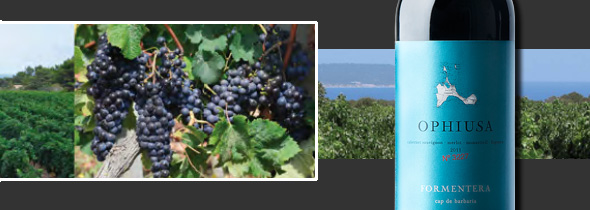
FORMENTERA
CAP DE BARBARIA

Cap de Barbaria
Zur Abrundung unseres balearischen Sortimentes, freuen wir uns, Ihnen etwas ganz Besonderes aus FORMENTERA anbieten zu können. Eleganz, Tiefe und eine leichte mediterrane Fruchtbetonung machen diese beiden Weine zu etwas ganz Besonderem. Kleinste Mengen verfügbar, da insgesamt nur 8000Fl. produziert.
Allgemeines:
Cap de Barbaria is a red wine, product of a blend, firstly, of two varieties very common on the island of Formentera – MONASTRELL and FOGONEU -, and secondly, of two more classical varieties, common throughout the world, CABERNET SAUVIGNON and MERLOT. The terrain where production of this wine begins comprises two plots, the larger one measuring one hectare, opposite the old estate manor house, now renovated and converted into a hotel. Here 60% Cabernet Sauvignon and 40% Merlot were grafted in December 1999 onto American 140 Ruggieri stocks with high planting density 5,500 vines/ha. The smaller plot measures just over half a hectare, with 40 to 50-year-old vines of ungrafted Monastrell and Fogoneu, which endow the Cap de Barbaria wine with its own particular character and personality. The high-density planting reduces the yield of grapes per vine but improves their quality.
Hektar : 3 gegründet : 2001 erste Ernte : 2004
Der Boden: The soil ranges from very sandy in part of the Merlot zone to very stony in the Cabernet zone. The rock is chalky, which aggravates the effects of lack of water and causes the plants to undergo additional stress. These particular soil features, combined with severe climatic conditions, including normally hot, dry summers, make monitoring the ripening process very important and the selection of grapes on the plant essential.
Die Rebsorten:
Cabernet Sauvignon, the red wine grape par excellence worldwide, although the grapes themselves are very small and production is far below average, is highly rated and easy to grow thanks to its adaptability to different climates and soils. It provides a richly coloured wine with aromas of fruits of the forest and notable tannin content. However, in warm climates such as Formentera’s theses qualities are considerably tempered. The Merlot variety, invariably associated with Cabernet by virtue of their common origin and complementary nature in wine making, the combination of which produces such favourable results in the Bordeaux region, adapts well to vineyards beside the Mediterranean characterised by high humidity levels, yielding a wine with plumy touches and a simple structure that often compensates for the astringency of Cabernet. Monastrell is a red wine variety native to Mediterranean regions than stands up well to the hot, dry climate. Its quality, which went unrecognised for a long time, is the product of the hydrological stress it habitually suffers throughout the growing cycle, producing full-bodied, deep-coloured, well-structured wines with a moderately fruity taste. Finally Fogoneu, which grows all over the Balearic Islands, is a variety that complements Monastrell, providing the wine with a different aroma what we might call a Mediterranean touch.
Ernte und Vergärung:
All the grape varieties are harvested separately, except for Monastrell and Fogoneu, which share a similar growing cycle. Ripening is strictly monitored. The grapes are collected only from areas where they are perfectly ripe and as often as necessary, special attention being paid to the skins. The wine is also made separately, in the classical way, which begins with picking – always by hand and, as mentioned above, with strict selection from the vine itself. Once in the winery, which stands on the domain itself next to the vineyard, the stalks are removed, the grapes are gently mashed and the stainless steel thanks are filled for fermentation. Once alcoholic fermentation of the must and the skins has begun, manual pumping over is carried out to break the cap or layer formed by the grape skins, pips and pulp that float to the surface during the fermentation. In this way, deeper greater colour is obtained and aromas and flavours are intensified. Fermentation is conducted at a controlled temperature of 26-28ºC in order to enhance theses qualities. When the fermentation process is completed, the wine remains in contact with the skins for a period that may last as long as thirty days, during which daily pumping over continues. Then pressing takes place and the wine goes into the barrels in the maturing room, where malolactic fermentation – transformation of the malic acid into lactic acid – occurs, making the wine more pleasant to drink.
Barrique-Reifung:
Cabernet and Merlot are matured in different types of French oak barrels – new and second year, while Monastrell and Fogoneu are matured in American oak. The time the wine stays in the barrels varies, and only sensory tests – tasting – can determine changes of barrel and the best moment to separate the wine from the wood. Decanting is carried out by gravity, applying a system for raising the barrels as gently as possible. The blending that will finally endow Cap de Barbaria with its characteristic personality depends on the development of the wine in each barrel as it is prepared for bottling. If the wine has not developed as we had hoped, it is decided not to put that particular vintage on the market.
Produktion: 8,000 bottles/year in cases of 6 bottles each.
Weinmacher und Direktor: Xavier Figuerola
Weitere Testing-Informationen finden Sie hier!